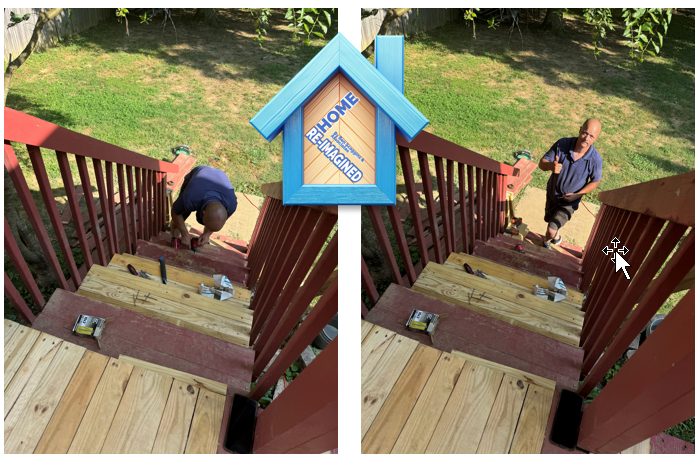We Build Steps and Rails That Are Code-Compliant!
When building or repairing steps outside, it is important to use pressure--treated wood to prevent moisture saturation of the wood which dramatically decreases the life span of the steps and rails. In the image below, you can see Ben replacing steps that a previous repair job six years before was done by another business that did not use pressure-treated wood. While working on this project he noticed the very large dog (see the storage building page on this site to see the Great Dane that the family owned) would run from the back yard to the stairs and bound up the steps only touching the middle step before being on top of the deck. Ben realized that the steps were originally built with no "back plates" - wood that is mounted vertically at the back of the step so to prevent unintentional slipping between the steps. When it rains, and especially when it is icy or snowy in the winter months, the dog was at risk of sliding one or more legs between the steps, which would likely have broken the dog's leg bones. As such, Ben disassembled every step (including the ones that did not need replacing), adding a back plate to each of the steps. The owners of the home were overjoyed that Ben had noticed the design flaw and corrected it to protect their beloved four-legged family member.
As for the rails, these are the old style, which this home owner preferred to keep. Many prefer for us to install heavy-gauge steel wiring horizontally instead of the vertical wood strips. For homes with a beautiful view that they do not want obstructed, thick plexiglass can be installed in wood framing for a clear view of the lake or hills their deck faces.


Building codes are in place to protect small children and adults at homes they live in or are visiting. These prescribe that stairs must be a  minimum of 36 inches in width. The maximum height from ground to the upper level for a single staircase is 12' 7" (or 151 inches) - if the distance exceeds that amount, a level landing must be in place in-between to break up the flight of stairs. The stair riser (height) between steps cannot exceed 7 3/4 inches and the stair treads nust be no less than 10 inches (with nosing projections) or 11 inches (nosing projection is not required. IN the steps shown on the right, they were originally plywood steps with carpet covering the entire steps. This owner desired real wood steps. If you look closely, you will see that these 10 inch stairs with one inch nosing projections on each (in other words, the rounded edge affixed to each step.
minimum of 36 inches in width. The maximum height from ground to the upper level for a single staircase is 12' 7" (or 151 inches) - if the distance exceeds that amount, a level landing must be in place in-between to break up the flight of stairs. The stair riser (height) between steps cannot exceed 7 3/4 inches and the stair treads nust be no less than 10 inches (with nosing projections) or 11 inches (nosing projection is not required. IN the steps shown on the right, they were originally plywood steps with carpet covering the entire steps. This owner desired real wood steps. If you look closely, you will see that these 10 inch stairs with one inch nosing projections on each (in other words, the rounded edge affixed to each step.
Adding the no slip carpet strips to the stairs ensures small children will not fall on the stairs, as they were used to completely carpeted stairs before this remodeling took place. These usually last around five years and can easily be replaced for around $50 with theier peel-and-stick backing.
The original rails and banister shown in the image on the right were made of wood, very simple and painted white, however, as you can see, this is now modernized to use real wood with decorative iron rails. Note that there are two vertical iron rails for each step. To comply with building codes, the space between the vertical rails cannot be wide enought for a toddler to slip through and fall. To say this looks much more modern would be an understatement.

 minimum of 36 inches in width. The maximum height from ground to the upper level for a single staircase is 12' 7" (or 151 inches) - if the distance exceeds that amount, a level landing must be in place in-between to break up the flight of stairs. The stair riser (height) between steps cannot exceed 7 3/4 inches and the stair treads nust be no less than 10 inches (with nosing projections) or 11 inches (nosing projection is not required. IN the steps shown on the right, they were originally plywood steps with carpet covering the entire steps. This owner desired real wood steps. If you look closely, you will see that these 10 inch stairs with one inch nosing projections on each (in other words, the rounded edge affixed to each step.
minimum of 36 inches in width. The maximum height from ground to the upper level for a single staircase is 12' 7" (or 151 inches) - if the distance exceeds that amount, a level landing must be in place in-between to break up the flight of stairs. The stair riser (height) between steps cannot exceed 7 3/4 inches and the stair treads nust be no less than 10 inches (with nosing projections) or 11 inches (nosing projection is not required. IN the steps shown on the right, they were originally plywood steps with carpet covering the entire steps. This owner desired real wood steps. If you look closely, you will see that these 10 inch stairs with one inch nosing projections on each (in other words, the rounded edge affixed to each step.